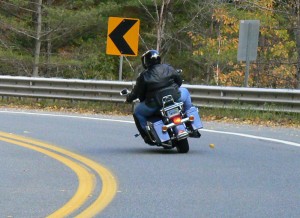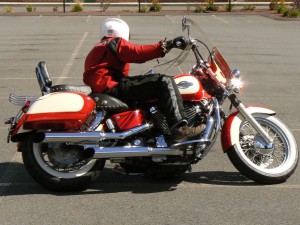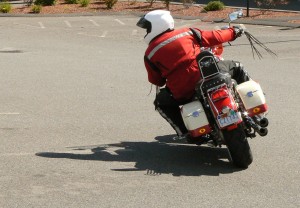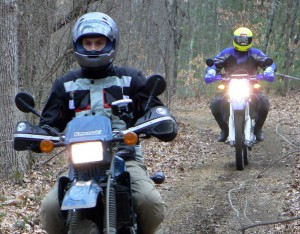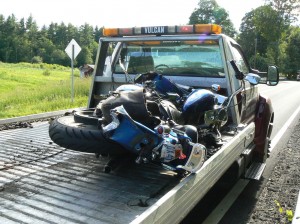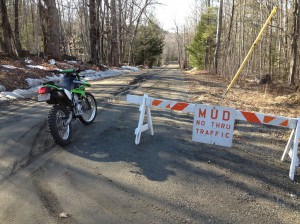
You’ve probably heard people say that dirt riding can help improve a road rider’s skill, but can it really make you a safer and more competent street rider? The answer is yes.
1. Improved Traction Sense
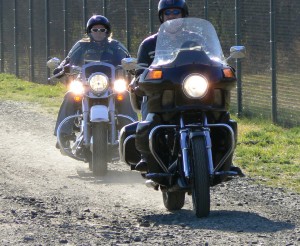
Managing traction is one of the highest priorities for any motorcycle rider, whether on street or off-road. Dirt riding provides ample opportunities to learn about traction management as the tires hunt for grip on unpredictable surfaces.
Having your motorcycle move around beneath you is disconcerting for street riders who are new to this sensation, but it helps you learn about traction management, including which inputs help and which hurt traction.
And this experience translates to street riding. Imagine yourself suddenly feeling your tires sliding as you roll over a wet surface or a bit of sand in a corner. Imagine your bike feeling like it is falling out from underneath you. Most street riders will panic, flinch and tense on the handlebars. This often makes matters worse.
With dirt riding experience, you are more likely to recover from a relatively minor slip instead of panicking and gripping the bars in fear. Previous experience can allow you to stay composed and relaxed so your inputs remain fluid, allowing the tires a chance to regain grip.
2. Clutch and Throttle Control
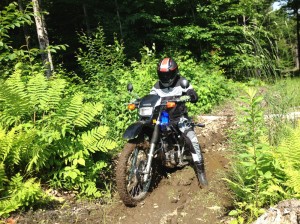
Throttle, clutch and brake control become very important when your tires are skipping over tree roots and wet rocks or through deep sand and gravel. But, you may not realize just how important fine clutch and throttle control affects a street rider’s confidence.
By perfectly timing clutch release and throttle application, you manage lean angle, traction and direction control. This is especially noticeable when downshifting as you enter a slow turn. If you downshift as you begin to tip into a turn, you must feed the clutch out smoothly to avoid abrupt driveline lash that can disrupt traction and direction control.
3. Slow Speed Skills
Off-road riding typically includes a lot of slow speed maneuvering, which means that your sense of balance at slow speeds will increase greatly. Maneuvering slowly over rough or loose terrain requires steady, smooth power delivery. This often means slipping the clutch to control the power and prevent instability and unwanted direction changes. Yet another reason why masterful use of the clutch is so important for precise control of forward drive, both on and off road.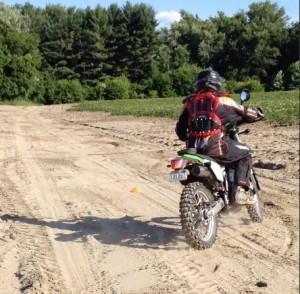
4. Balance and Body Position
Because a lot of off-road riding is done at slow speeds over uneven surfaces, maintaining balance is a constant issue. The technique for maneuvering any motorcycle at slow speeds is to counterweight so that the motorcycle leans independently of your upper body. Counterweighting keeps the center of gravity over the tire contact area to maintain grip when traction is low.
Riding a lightweight dirt bike means that much more of the steering is done with the footpegs and body. By positioning your body forward, rearward and side to side, you influence direction control.
You’ll need to learn to ride while standing on the footpegs to allow your legs to act as shock absorbers. This can be tiring at first, until you learn the proper “neutral” position that keeps your bodyweight over the balance point of the bike, usually over the front of the fuel tank, knees slightly bent and elbows out.
On the street, you use many of these techniques as you cross speed bumps, railroad tracks or when ascending or descending steep hills at slow speeds.
5. Throttle and Brake Steering
Another important thing to learn when dirt riding is how to use the throttle and rear brake to change direction by breaking the rear tire loose under acceleration or when braking. It’s scary at first, but once you learn these techniques, your confidence will grow quickly.
On the street, you will have a better sense of how the throttle can help “finish” a turn or how deceleration and brake force can alter your cornering line. Motorcycle dynamics are similar enough between lightweight, off-road bikes and heavy street bikes for this skill to transfer.
6. Improved Brake Control
The front brake offers the most braking power whether riding on or off road, however the rear brake becomes more important when riding in the dirt. When traction is low, the amount of brake force is minimized and load transfer that pitches the bike forward is reduced, which means that the rear of the bike remains more planted for more effective rear brake power.
Another reason to favor the rear brake is to avoid a front tire skid, which must be avoided if you want to remain on two wheels. Loose surfaces are unpredictable, so it’s best to apply more rear brake pressure and modulate the front brake to avoid a skid.
On the street, you learn that there are times when you favor the rear brake a bit more. Riding with a passenger and descending a gravel road are two instances that come to mind.
7. Improved Visual Skills
Off-road riding requires keen vision. One of the keys to a successful off-road outing is the ability to identify the best line through a rocky or sandy trail or fire road so that you find the best available traction. A common problem that new riders have is their inability to keep their eyes well ahead, scanning for the ideal line.
This translates directly to street riding. Nervous riders look down, which leads to higher perceived speeds, and more panic as hazards seem to appear “out of nowhere”. Eyes Up!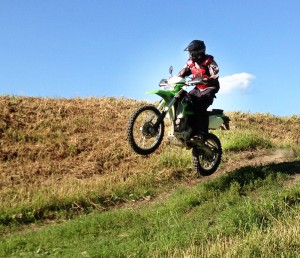
8. Better Fitness
Riding on the street can be tiring and can make you sore. But, that doesn’t mean you’re getting into shape. If you want to increase muscle tone and strength, get yourself off-road. The act of balancing a motorcycle over rough terrain is one of the best workouts you’ll experience. Bring a hydration system…you’ll need it.
9. Learn to Fall Down
You won’t likely become a texting teenager’s hood ornament when riding off-road, but there is still significant risk.
Even though crashes are usually less serious, the frequency of tip overs tends to be higher when off-road riding. Typical injuries usually consist of bumps, bruises and perhaps a torn ligament or broken bone if you’re unlucky. Because of these challenges, you should not ride alone without the help of someone to come to the rescue if necessary.
Learning to fall is not usually something I emphasize. Instead, I prefer to teach people how NOT to fall. But, there is something beneficial about being familiar with hitting the deck that can potentially help you if you were to crash on the street, such as trying to relax (yeah, right) or keeping arms tucked in if you tumble. Think of sports players who learn to fall without injury; that’s the theory.
10. Gain a New Respect for Riding Gear
Whether riding on the street or off-road, it’s important to reduce the likelihood of injury and this means wearing protection. No sane person I know would hit the trails without full protection. I’ve seen too many riders fall down and get a rock in the ribs or a stick in the chest to not wear full gear. Not to mention bruised ankles and nasty rash. And that is falling at under 20 mph. You know what happens if you were to hit pavement at 40 mph with inadequate clothing…not pretty. ATGATT, people.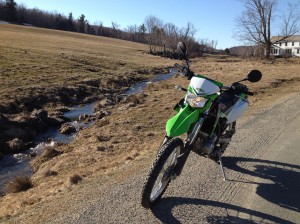
Get Dirty, Skillfully
With good skills, falling can be minimized. But for many, tipovers are a reality when riding off-road, which means you must manage the risks. Don’t take your safety for granted. Learn to ride well! Prepare your mind with an attitude toward reducing risk and protect your body with proper riding gear.
There is a lot more to learn about off road riding. Understand that just because you can ride a street bike does not mean that you can swing a leg over a dual-purpose bike and safely hit the trails. But, it is well worth the effort.
What are your experiences with how off-road riding helps your street riding?
Please Donate to Keep the Articles Coming
If you liked this article and the many other articles on this site, please toss a buck or five into the hat. It’s greatly appreciated!
- Click the PayPal “Pay Now” button.
- Then indicate quantity in $2.00 increments. – Example: put “2” in “QUANTITY” field to donate $4.00, “3” for a $6.00 donation, etc.
Why $2.00? Due to the PayPal fee structure, a $2.00 donation is significantly more beneficial compared to a $1.00 donation.
Thank You!
Check out these related posts:
- Dual Sport Motorcycling: Discovering My Little Town
- Is Rider Training Effective?
- How to Develop a Traction Sense
- #1 Reason for Motorcycle Crashes in Corners
Stay Informed: Subscribe NOW!
Be a Better Rider: Sign Up for Personal Training with Ken
Support Riding in the Zone: Buy a book
Support Riding in the Zone: Buy recommended products from Twisted Throttle & Amazon
